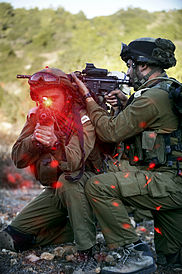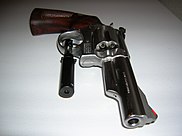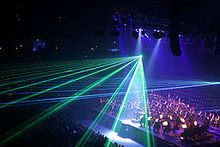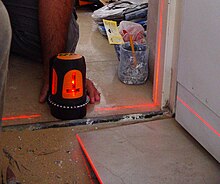
A laser is a device that emits light through a process of optical amplification based on the stimulated emission of electromagnetic radiation. The word laser is an anacronym that originated as an acronym for light amplification by stimulated emission of radiation. The first laser was built in 1960 by Theodore Maiman at Hughes Research Laboratories, based on theoretical work by Charles H. Townes and Arthur Leonard Schawlow.

Microscopy is the technical field of using microscopes to view objects and areas of objects that cannot be seen with the naked eye. There are three well-known branches of microscopy: optical, electron, and scanning probe microscopy, along with the emerging field of X-ray microscopy.

A laser diode is a semiconductor device similar to a light-emitting diode in which a diode pumped directly with electrical current can create lasing conditions at the diode's junction.

A dye laser is a laser that uses an organic dye as the lasing medium, usually as a liquid solution. Compared to gases and most solid state lasing media, a dye can usually be used for a much wider range of wavelengths, often spanning 50 to 100 nanometers or more. The wide bandwidth makes them particularly suitable for tunable lasers and pulsed lasers. The dye rhodamine 6G, for example, can be tuned from 635 nm (orangish-red) to 560 nm (greenish-yellow), and produce pulses as short as 16 femtoseconds. Moreover, the dye can be replaced by another type in order to generate an even broader range of wavelengths with the same laser, from the near-infrared to the near-ultraviolet, although this usually requires replacing other optical components in the laser as well, such as dielectric mirrors or pump lasers.
The term biophotonics denotes a combination of biology and photonics, with photonics being the science and technology of generation, manipulation, and detection of photons, quantum units of light. Photonics is related to electronics and photons. Photons play a central role in information technologies, such as fiber optics, the way electrons do in electronics.
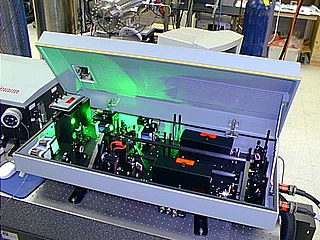
Nd:YAG (neodymium-doped yttrium aluminum garnet; Nd:Y3Al5O12) is a crystal that is used as a lasing medium for solid-state lasers. The dopant, triply ionized neodymium, Nd(III), typically replaces a small fraction (1%) of the yttrium ions in the host crystal structure of the yttrium aluminum garnet (YAG), since the two ions are of similar size. It is the neodymium ion which provides the lasing activity in the crystal, in the same fashion as red chromium ion in ruby lasers.
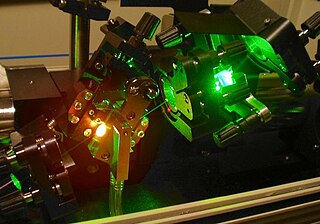
Ti:sapphire lasers (also known as Ti:Al2O3 lasers, titanium-sapphire lasers, or Ti:sapphs) are tunable lasers which emit red and near-infrared light in the range from 650 to 1100 nanometers. These lasers are mainly used in scientific research because of their tunability and their ability to generate ultrashort pulses thanks to its broad light emission spectrum. Lasers based on Ti:sapphire were first constructed and invented in June 1982 by Peter Moulton at the MIT Lincoln Laboratory.
A diode-pumped solid-state laser (DPSSL) is a solid-state laser made by pumping a solid gain medium, for example, a ruby or a neodymium-doped YAG crystal, with a laser diode.

Many ceramic materials, both glassy and crystalline, have found use as optically transparent materials in various forms from bulk solid-state components to high surface area forms such as thin films, coatings, and fibers. Such devices have found widespread use for various applications in the electro-optical field including: optical fibers for guided lightwave transmission, optical switches, laser amplifiers and lenses, hosts for solid-state lasers and optical window materials for gas lasers, and infrared (IR) heat seeking devices for missile guidance systems and IR night vision. In commercial and general knowledge domains, it is commonly accepted that transparent ceramics or ceramic glass are varieties of strengthened glass, such as those used for the screen glass on an iPhone.

Laser radiation safety is the safe design, use and implementation of lasers to minimize the risk of laser accidents, especially those involving eye injuries. Since even relatively small amounts of laser light can lead to permanent eye injuries, the sale and usage of lasers is typically subject to government regulations.

A tunable laser is a laser whose wavelength of operation can be altered in a controlled manner. While all laser gain media allow small shifts in output wavelength, only a few types of lasers allow continuous tuning over a significant wavelength range.
A vertical-external-cavity surface-emitting-laser (VECSEL) is a small semiconductor laser similar to a vertical-cavity surface-emitting laser (VCSEL). VECSELs are used primarily as near infrared devices in laser cooling and spectroscopy, but have also been explored for applications such as telecommunications.

A laser pointer or laser pen is a handheld device that uses a laser diode to emit a narrow low-power visible laser beam to highlight something of interest with a small bright colored spot.
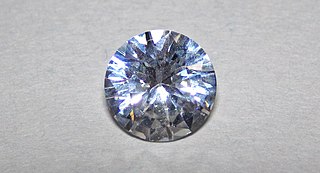
Yttrium aluminium garnet (YAG, Y3Al5O12) is a synthetic crystalline material of the garnet group. It is a cubic yttrium aluminium oxide phase, with other examples being YAlO3 (YAP) in a hexagonal or an orthorhombic, perovskite-like form, and the monoclinic Y4Al2O9 (YAM).
Ultrafast laser spectroscopy is a category of spectroscopic techniques using ultrashort pulse lasers for the study of dynamics on extremely short time scales. Different methods are used to examine the dynamics of charge carriers, atoms, and molecules. Many different procedures have been developed spanning different time scales and photon energy ranges; some common methods are listed below.

The Raman microscope is a laser-based microscopic device used to perform Raman spectroscopy. The term MOLE is used to refer to the Raman-based microprobe. The technique used is named after C. V. Raman, who discovered the scattering properties in liquids.
The technique of vibrational analysis with scanning probe microscopy allows probing vibrational properties of materials at the submicrometer scale, and even of individual molecules. This is accomplished by integrating scanning probe microscopy (SPM) and vibrational spectroscopy. This combination allows for much higher spatial resolution than can be achieved with conventional Raman/FTIR instrumentation. The technique is also nondestructive, requires non-extensive sample preparation, and provides more contrast such as intensity contrast, polarization contrast and wavelength contrast, as well as providing specific chemical information and topography images simultaneously.
The Beckman Laser Institute is an interdisciplinary research center for the development of optical technologies and their use in biology and medicine. Located on the campus of the University of California, Irvine in Irvine, California, an independent nonprofit corporation was created in 1982, under the leadership of Michael W. Berns, and the actual facility opened on June 4, 1986. It is one of a number of institutions focused on translational research, connecting research and medical applications. Researchers at the institute have developed laser techniques for the manipulation of structures within a living cell, and applied them medically in treatment of skin conditions, stroke, and cancer, among others.

Lightwave Electronics Corporation was a developer and manufacturer of diode-pumped solid-state lasers, and was a significant contributor to the creation and maturation of this technology. Lightwave Electronics was a technology-focused company, with diverse markets, including science and micromachining. Inventors employed by Lightwave Electronics received 51 US patents, and Lightwave Electronics products were referenced by non-affiliated inventors in 91 US patents.
Laser welding of polymers is a set of methods used to join polymeric components through the use of a laser. It can be performed using CO2 lasers, Nd:YAG lasers, Diode lasers and Fiber lasers.


